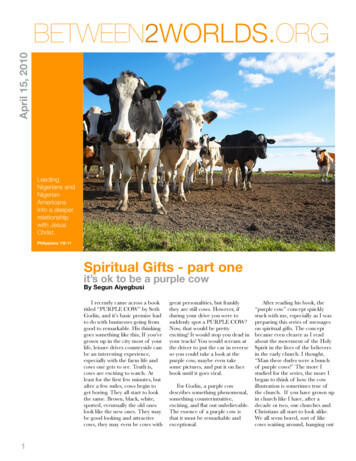
Transcription
ISSN 1799-2591Theory and Practice in Language Studies, Vol. 9, No. 8, pp. 965-972, August 2019DOI: http://dx.doi.org/10.17507/tpls.0908.11Reading The Color Purple from the Perspectiveof EcofeminismLianghong WuThe Faculty of Foreign Languages, Huaiyin Institute of Technology, Huai’An, Jiangsu 223001, ChinaAbstract—Alice Waker is one of the most influential black female writers in modern America. The summit ofher literary achievements, The Color Purple, wins her three awards since its publication and becomes amilestone in the black literature. This paper sums up the three stages of the relationship between human,women in particular, and nature---fragmentation, over-sewing and wholeness. In this novel, Walker attemptsto arouse black women’s self-consciousness by showing the fragmentation state of black women and natureunder oppressions. She looks for ways of oversewing the broken souls to realize the wholeness of survival.Advocating people to attach importance to the problems of women and environment, Walker expresses herecofeminist consciousness to establish a harmonious society where human and nature, men and women couldco-existent peacefully.Index Terms—Alice Waker, The Color Purple, ecofeminismI. A BRIEF INTRODUCTION TO ALICE WALKER AND THE COLOR PURPLEAlice Walker is one of the most influential writers in contemporary American literary field. She is not only the firstblack female Pulitzer winner in American history, but also reputed as a writer comprehensively representing our times.Walker, coining the term “Womanism”, is the spokeswoman of the black women in America who have been ignored bythe main-stream culture. Actually, most of her works are feminist- and black-oriented, which go deep into their innerworld, portray their suffering, awakening, resistance and independence, and speak highly of their tenacious livingability and strong will of fighting in adversity as well.The Color Purple, generally considered one of her best works, won her three great American literary awards since itspublication in 1982 and is undoubtedly regarded as a great and long lasting masterpiece of American literature. It hascaptured intensive attention in both western and domestic critical circles. Critics’ research on it covers a wide range oftopics. The theme of the novel and the characterization are often the major concerns of scholars. For example, JudithPlant interprets the subject about Celie’s status and believes that holding the naming right can make a forceful standagainst fatalism and sexism. (Plant, 1989). There also exists certain research on religion and culture revealed in thenovel, as Li Jin points out the importance of religion and culture for the rebirth of black women. (Li, 2004). Someessays have been devoted to “womanism” in this novel, among which Dr. Wang Xiaoying, shows clearly that the pursuitof human’s whole survival, permeating Walker’s literary creation, constitutes the soul of womanism advocated byWalker. (Wang, 2006). Some other comments tend to discuss the writing techniques employed in the book, including thenarrative strategies, epistolary structure, the language features, etc.These critics at home and abroad do provide deep insight and broad perspectives for the reader to understand theworks better. Undoubtedly the close link between race, gender and nature demonstrated by Walker in the novel doesdeserve further studies. This thesis intends to read The Color Purple from the ecofeminist perspective, and offer arelatively comprehensive and detailed look into Walker’s ecofeminist consciousness in order to evoke more people’senvironmental awareness and to make it easier to build a harmonious world.II. A BRIEF INTRODUCTION TO ECOFEMINISMSince the 1950s, as people are aware of the constantly deteriorating crisis of ecology and the necessity of survival ina clearer way, the ecological and greening thoughts have spread to every corner of human society. With the publicationof Rachel Carson’s Silent Spring, a milestone in both ecological history and eco-literature, the ecological movementflourished in the late sixties and early seventies insisting on new vision of society on a par with the peace movement,the civil rights movement, and women’s movement. But that was far from perfect since the close relationship betweenfemale and ecology hasn’t been paid much attention to. Under this circumstance, ecofeminism appears, in the 1970s, asa social and political movement sharing the considerable common ground between environmentalism and feminism.Ecofeminists point out that the patriarchal world view leads to the oppression of women and the destruction and misuseof nonhuman nature in the male-dominated culture.Ecofeminism was first coined by Francoise d’Eaubonne in her book Le Feminisme ou la Mort in 1974. Spretnak, aclassic ecofeminist, defines ecofeminism as “a joining of environmental, feminist, and women’s spiritual concerns.”(Spretnak, 1990, p.5-6) Warren asserts that “what makes ecofeminism distinct is its insistence that nonhuman nature 2019 ACADEMY PUBLICATION
966THEORY AND PRACTICE IN LANGUAGE STUDIESand naturism are feminist issues.” (Warren, 1997, p.4). Susan Griffin, in Woman and Nature, states that women havesome level of communion with nature that men can not attain. Though the understanding of ecofeminism varies fromperson to person, ecofeminists share a common awareness of the inextricable connections between women and nature.Econofeminists advocate the need to establish a harmonious society that connects nature and humans, male andfemale, rich and poor. As a black woman writer, Walker expresses her eagerness for the equality of all the living thingsin the world. In The Color Purple, Walker describes her deep concern for the binary oppositions between male andfemale, humans and nature, and her worries about the earth environment and the status of women. In the novel, therelationship between male and female, humans and nature is in progress and it experiences three different stages forfragmentation, oversewing and wholeness.III. FRAGMENTATION--WOMEN AND NATURE: VICTIMS OF THE PATRIARCHAL SOCIETYAccording to ecofeminists, the exploitation of women and domination of nature are interconnected, which is theresult of Western male dominance. In other words, both women and nature are the victims of patriarchy. The main taskof ecofeminists is to criticize the patriarchal oppression of women and nature. In The Color Purple, both therelationships between human and nature and that of men and women are previously in a state of fragmentation. Womenand nature have long been rendered objects of attention, domination and conquest by patriarchy, which make them in aninferior position. They both lie in the marginalized area of the world.A. The Maltreatments of Black WomenIn The Color Purple, Walker expresses her deep sympathy for the black women by depicting their dual oppressionsfrom racism and sexism in patriarchal society. They are tortured both mentally and physically, deprived of all the rightsand even their status and individuality.The racial conflict between the black and the white in this novel is very conspicuous. The white people constitute themainstream of the society and have all the privileges over the black. They think they are the saviors of the black whohave freed them from slavery, so they have the right to rule them. Therefore black women are always expected to keepobedient and those who dare to resist will undoubtedly have severe penalty. Sophia is just a typical victim of racism inthe novel. Although a black girl, she fights frequently against someone who does wrong to her, including the mayor ofthe city. Yet unfortunately, her struggle couldn’t change her fate, instead, it brings her tragedy. Because of her sassingthe mayor’s wife and hitting the mayor, she is put in prison where she experiences all kinds of hardships one canimagine: being beat,humiliated and forced to do hard jobs. What’s worse is that she is then transferred to the mayor’shome as a maid. In this way, she is tortured and the white people finally attain their aim to make her as submissive asother black women.Being at the bottom of the society, besides racism, another major threat to the black women is from sexism, whichinvolves rape, deprivation of rights, and psychological control. In The Color Purple, the female characters areconsidered to be mules, whose will is subjugated to the will of the men. As victims of patriarchy and male chauvinism,most of them have the experience of being raped, being deprived of basic human rights and finally becomepsychologically controlled by men.Take Celie, the protagonist of this novel, as an example. She is raped by her stepfather when she is only 14 years oldand later gives birth to two children. After her stepfather’s repeated physical and sexual violence, Celie is sold to awidower with four children to tend to. It’s her industriousness and obedience as well as an attached cow that leads to thewidow’s decision of marrying her. However, this marriage doesn’t eliminate any slightest oppressions she suffers butthrows her into another “cage”. To the widower, her so-called husband, she is nothing but a laborer in the field, aworker for domestic household and a sexual servant.According to the traditional western culture, women are universalized as passive, fragile and inferior to men. Thenthe black women are in the poorer condition, who are stripped of all the rights and hence lose their individuality. Firstly,the black women are deprived of economic freedom. In the The Color Purple, the Olinka women are the ones who workhard in the field, with their husbands idling about all day long, but nothing in the household belong to them. Withoutmoney to support themselves, women could only depend on men for survival. Secondly, the black women hardly haveopportunity to receive education. In the novel, Celie isn’t the only one forbidden to school by men. In Olinka in Africa,girls are kept at home to do housework while boys go to school. Since they believe knowledge is power, men are afraidif women possess the power, women may find out the truth hidden by the regime and finally endanger their authority.Thirdly, the black women are stripped of their right to speak. In the novel, those who desire to make their inner thoughtsheard will be cruelly beaten by men. The patriarchal authority makes women keep silent so that men’s crimes could beconcealed and their exploitation of women will never cease.The black women in the novel, with the traditional idea that women are born to be humble, do believe without doubtsthat they are inferior to men, and they ought to put up with all these tortures poured onto them. This kind of mentaltorture is actually the most severe misfortune for them and by doing so men could practice their supremacy throughtheir psychological control over women. Oppressed both physically and mentally, the black women are bearing theburdens that everyone else refuses to carry, and play roles of mule in patriarchal society. They lose their status andindividuality. Simone de Beauvior writes in the introduction to The Second Sex that “She is defined and differentiated 2019 ACADEMY PUBLICATION
THEORY AND PRACTICE IN LANGUAGE STUDIES967with reference to man and not he with reference to her; she is the incidental, the inessential as opposed to the essential.He is the Subject, he is the Absolute—she is the other” (Beauvoir, 1972, p.16). It’s self-evident that women, withoutindependent status and identities, couldn’t escape the fate to be men’s accessories or playthings in male-dominatedsociety.B. The Devastations of NatureIn western culture, nature has always been considered something to be suppressed and overcome and naturalresources should be used to serve the needs of men. In fact, human beings’ attitude toward nature could be traced backin the Bible. When God creates everything in the world, he says, “ let them (humankind) have domination overcreeping thing that creeps upon the earth.” “I have given you every plant and every tree; you shall have them forfood.”(Holy Bible, 2) Having been greatly influenced by this value, human beings have no doubts that they are thecontrollers and masters of nature. As a result, they have a random exploitation of nature, which leads to the destructionof the natural world.With the emergence of environmental crisis, the protection of nature has become an international issue of increasingsignificance. More and more people get to know the crisis of ecology and start to explore the root of it. Rachel Carsoncriticizes that mankind has sought to insulate himself, in his cities of steel and concrete, from the realities of the earthand water and the growing seed. Intoxicated with a sense of his own power, he seems to be going further and furtherinto more experiments for the destruction of himself and his world. Ecofeminist believe human’s over-exploitation ofnature is rooted in anthropocentrism. In other words, men’s domination of all the creatures in nature leads to thedevastation of nature. Walker, along with other ecofeminists, attacks chauvinistic and anthropocentric views aboutnature, seeing nature as the source of energy, the place where everything coexists. In The Color Purple, in order toarouse people’s attention to the disastrous natural world, she presents before the reader the environmental deteriorationin Olinka.According to Nettie’s letters, Olinka previously is a peaceful village located in Africa where people live in a “placewithout walls but with a leaf roof” (Walker, 1982, p.141). And there are “trees and trees and then more trees on top ofthat. They are so big they look like they were built. And vines. And ferns. And little animals. Frogs. Snakes too.”(Walker, 1982, p.139). The natives live in a peaceful natural environment. But the appearance of the white road buildersbreaks the harmonious scenery. It is posited that almost overnight, the Olinka village turns to be the territory of thewhite colonists with the fields being occupied, huts leveled, leaves of the trees cut away. In addition, the victims of thisecological disaster include not only the Olinka village but also its neighbor villages. The white colonizers aim to turnthe village into a headquarter of the rubber industry by replacing the forest with rubber trees. The biological balance iscompletely destroyed with the animals nowhere to stay, and local people being expelled away from their homeland andforced to buy water from the planters. The white colonists, under the cloak of modern civilization, succeed inconquering the peaceful creatures there and destroying the previous ecological environment as well.As above-mentioned, Olinka is not the only place that suffers from deteriation. According to Doris Baines, asixty-five-year-old woman whom Nettie and Samuel meet on their way back to England, signs of war are all over Africaand India. Trees are hauled off to make ships and captain’s furniture, while the land is planted with something peoplecan’t eat. Animals are also victims of advanced human society from the primitive one to modern one, with their meatcooked into food, fur made into clothing, bones into ornament.In addition to arousing people’s attention to the problem of environment, Walker’s portrait of the destructiveness ofnature in the novel implies her attack against the dominant hierarchy system and the mainstream westernanthropocentric aggression. There’s another point in the novel that needs to be noted. Before the aggression of the whitecolonists, people in Olinka have gone through the disaster caused by their destroying the balance of ecology. Thisexperience teaches them the lesson of the importance of keeping a harmonious relationship with nature and this lessonis then passed on from generation to generation among them. However, their awareness isn’t enough to protectthemselves and their natural world. The white people’s colonialism once again puts them in the environmental crisis.Here, Walker intends to criticize the conspiracy of racism and colonialism that leads to the severe ecological crisis. Sheis convinced that economic profits drive men to over-exploit nature and it’s men’s inherent depravity that bring abouttheir reckless oppression to nature. Walker believes that only when all human beings tend to protect environmentconsciously and put themselves in the same position as nature, could all the creatures in the world live peacefully andharmoniously.C. Natural Alliance between Women and NatureFrom what’s analyzed above, it’s self-evident that women and nature share the same miserable fate under commonoppressions. The connection between women and nature lies biologically in women’s reproductive roles aschild-bearers as well as the language used to describe women and nature: women are often described in animal termssuch as cows, foxes, etc. On other hand, nature is often described in female and sexual terms: nature is raped, mastered,conquered, and controlled. Because of this interconnection, when suffering from oppression, women tend to get mergedwith nature to pursue power and comfort from it; whereas being happy, they can also generate resonance with nature.Based on the fact, it truly brings the two together so closely that they form natural alliance, a strategy of vital toovercome and survive the patriarchal society. In the novel, there are many natural images bearing this kind of 2019 ACADEMY PUBLICATION
968THEORY AND PRACTICE IN LANGUAGE STUDIEScharacteristic like tree, the hut in Olinka,etc.In The Color Purple, natural alliance between women and nature first presents itself in the close relation existingbetween women and tree. Trees have always been described as the selfless giver in various cultures. Walker hasemphasized this view that “we are connected to them (the animals) at least as intimately as we are connected totrees.”(Walker, 1999, p.310) In The Color Purple, Celie regards tree as her redeemer, whenever she is beaten, she tellsherself: “all I can do not to cry. I make myself wood. I say to myself, Celie, you a tree. That’s how come I know treesfear man.”(Walker, 1982:30) She, in adversity, is so helpless and powerless that she can only turn to the trees forcomfort. Shug Avery has special affections to trees, too. As for her, trees also have feelings and ought to be protected.She says “My first step from the old white man was trees. Then air. Then birds. Then other people being cut, the armwould bleed and people would feel pain; being felled, the tree would also bleed.” (Walker.1982, p.185)The hut in Olinka also displays the inseparable relations between women and nature. In Nettie’s narration, the hut,“unlike their school, which is square, and unlike their church, which doesn’t have walls---at least during the dryseason---the hut is round, walled, with a round roofleaf roof.” (Walker.1982, p.158) As is known that square representslaw, rule and order, while round is symbolic of nature, peace and comfort. Therefore round has special appeal to women.From women’s affections to hut, it can be said that their outpouring of love for nature is obvious. It just reflects fromanother aspect the natural alliance between women and nature in the novel.Nature constitutes the tie closely connecting women. Women’s life can’t be separated from nature, and their realpsychological protector is not God but nature. In The Color Purple, Celie and her sister Nettie, though separated from along distance, enjoy mutual telepathy and resonance in their hearts through nature. As long as they are under the samesky, they can gaze into the eyes and share the feelings of each other. Through their arduous work in the fields Olinkawomen do strengthen their affections to nature. and become allies with nature.Another close alliance between women and nature lies in the fact they are oppressed and dominated by men. With theprobe into the inner connections between women and nature, ecofeminists get to know that the root of domination overwomen and nature is the Western traditional thought—hierarchical dualism which divides the world into pairs of entities,such as men and women, human and nature, mind and body. In each pair, the first entity is always in a superior positionto the second one, the common things the two entities share being ignored and differences being over-emphasized. Thisidea could explain why women and nature have become the objects of the male control in patriarchal society. Byshowing this point in the novel, Walker just deduces that to end the oppression of women and nature people musttranscend the most basic conceptual categories of hierarchical dualism.Just as what Walt Whitman, a prominent American poet, remarks, “Each of us inevitable; each of us limitless—eachof us with his or her right upon the earth; each of us allowed the eternal purports of the earth; each of us here as divinelyas any is here.” (Whitman,2004, p. 27) It advocates for the equal right between men and women and pursues for eternalco-existence, which is one of core goals of ecofeminism. Although human beings have power gaining over nature, theyought to use it in a humanistic way. Otherwise, they would end with being destroyed by nature.IV. OVERSEWING--THE AWAKENING OF HUMAN AND THE REVENGE OF NATUREToo much water drowned the miller. Neither women nor nature would like to receive the torture from men willingly.Men’s unbearable oppression on women and insatiable demands for nature will finally meet resistance from women andrevenge from nature. It can be proved from feminist movement started from the late 19th century and continuous naturaldisasters in modern society. According to ecofeminists, women’s awareness of their due rights and nature’s revenge onhumankind are the essential steps to establish the harmonious society. With the revenge of nature and the awakening ofwomen, men are forced to contemplate the whole situation. Under pressures, they recognize that women and nature areno longer under their control, and their only solution to survive lies in throwing away the previously traditional thoughtsand pursuing equity among women, nature and themselves. Walker thinks the process of oversewing makes the relationbetween human and nature, men and women move towards balance.A. Women’s AwakeningIn The Color Purple, with the help of sisterhood, women under the highly strict suppression and dominationgradually realize the necessity of spiritual liberation, learning the truth that they should have known and the rights theymust possess. Black women’s collective life and helpless state brought by slavery and androcentricism make it easy forthem to seek solace and happiness from other black women rather than men. Sisterhood delivers support and strength tohelp black women fight against their fierce oppressions. It is regarded as an important way to the women’sconsciousness-raising.In the novel, most women have experienced the change in their spirit from naivety to maturity. They help each otherto learn the truth and finally realize the importance to unite themselves. Suffering from repeated physical andpsychological abuse, Celie at the beginning can find nobody to turn to but confide to the God by writing letters. Sheimagines God to be “big and old and tall and gray bearded and white. He wear robes and go barefoot” (Walker, 1982,p.201) telling him everything including her confusions, worries, and even some secrets. She bears in her heart a beliefthat as long as she can write the word “God”, she has a companion; and that God will rescue people when they are introuble. Even when Sofia is thrown into jail Celie still fancies God’s rescue. Finally, the real redeemer turns out to be 2019 ACADEMY PUBLICATION
THEORY AND PRACTICE IN LANGUAGE STUDIES969Mary Agnes. It’s under Shug’s instructions that Celie realizes that “God is not a white, not a man. God is everything,just inside of everyone.” (Walker, 1982, p.202). With the help of other women, Celie eventually learns God in factdoesn’t exist in the world. Then she starts to communicate with other women to get help and courage.Another truth women in the novel learn is the necessity to appreciate their own beauty, to shake off the dominationsand to be themselves. For instance, the encouragements of vital significance from Shug do stimulate Celie’stransformation. When Celie knows that Albert has hidden all Nettie’s letters, she, who used to obeying every instructionof her husband, gets erupted and makes the decision to go to Memphis with Shug. She responds to Albert’s mocksaying” I’m pore, I’m black, I may be ugly and can’t cook, a voice say to everything listening. But I’m here.” (Walker,1982, p.214), which is actually her declaration of independence and resistance to the patriarchal society. Now she isasking for the equal rights to men instead of the mercy from them. It can be concluded that these great changes in Celiesuggests the black women’s progress in consciousness.B. Nature’s RevengeAs Susan Griffin writes: “We say he should have known his action would have consequences We say every actcomes back on itself. There are consequences. You can not cut the trees without a flood.”(Griffin, 1978, p.186)Human’s constant over exploitations on nature will inevitably stir its resistance, namely, its revenge on human. Just asthe proverb shows us—“fire and water are good servants but bad masters”, human beings have tasted the bitter fruit oftheir own behavior and are meant to realize that it’s time to balance their relationship with nature in the planet. In thisnovel, the Olinka people unfortunately become the objects of nature’s revenge.To them, the roof leaf is a savior to protect them from natural disasters. But one time, in order to make profits out ofthe land on which the roof leaf is cultivated, the chief asks people to remove the roof leaf to plant economic crops likecassava, groundnut. Then they get abused by the wind when the storm comes: their hut fall and many people get highfevers which even cause death. By the end of the rainy season, half of the village is dead. They pay high price for theirstupid behavior and eventually come to know the interdependent relationship between human and nature. So after therain stops, they search everywhere for the root of the trees, and immediately cover the land with the roof leaf again. Thisbrings the village to its previous peaceful state again.After the white colonists cut down all the roof leaves, the Olinka people suffer revenge again: “they have been eatingyams to prevent malaria and to control blood disease for thousands and thousands years. Without sufficient supply ofyams, the people are sickening and dying at an alarming rate” (Walker, 1982, p.250). It’s really sad that the Olinkapeople should pay off for the evil actions taken by the white colonists, just like the reason why people forever are thevictims of wars no matter what the motive of the war is.As an equal part of the ecological system, human beings always set themselves as the dominators, and act the role ofexploiter and destroyer, which causes the deterioration of ecological system and even makes it on the verge ofbreakdown. If people don’t stop it, human beings doom to be destroyed by nature one day.C. Men’s AwakeningThe androcentric ideology has deprived black men of their soul freedom and humanity and left them in lovelessmarriages. Women’s increasing resistance and nature’s revenge put men in a position where they have to rethink deeplythe whole situation. Only when they realize their previous evils to black women and nature can they throw off themasculinist thoughts and reach the goal of self-healing. It’s Walker’s belief and dream for men’s final disillusionmentthat sets the male characters in this novel to achieve spiritual survival, and change their attitudes toward both womenand nature.The awakening of black women’s self-sense is a major element leading to men’s transformation. In the novel, afterCelie starts her way of a new life, tremendous changes take place in Albert’s fate. Thus his awakening starts with Celie’sleaving for Memphis. He gets himself locked in the house and wouldn’t let anybody in. To be exact, he lives like a pig.During the period when Celie is absent, Albert makes retrospections unconsciously, rethinking about various kinds ofviolence he exercises on Celie since their marriage, Celie’s value to him as a woman, and the changes of his life afterCelie’s leaving. He then omes to a conclusion that women, with their own dignities, should be treated equally and beloved. His abandoning the traditional masculinist ideology also stimulates him to do something he has never donebefore. All these changes prove that he has experienced an ecofeminist-like rebirth and now is a natural man.Besides, true love also contributes to men’s progress in consciousness. Since Albert is not the only one experiencingtransformation, compared with his father’s change, Harpo’s is more believable to be a result of the true love betweenSophia and him. At first, their family circumstance is quite harmonious: Sofia works in the field or chops wood whileHarpo does cooking and cleaning at home. Though violating the traditional family model, they feel at ease in this way.The reason why he tries to control Sophia is that other men are doing this like his father, grandfather, etc. Out of outerpressure, he is destined to do so. After a series of incidents, he also gives up his attempts to bring his wife under control,realizing that it’s not a shame for not controlling Sophia but allowing her to do things at her own will. This becomes amajor theme of this novel that “love redeems, meanness kills” (Perseott, 1982, p.67) His efforts to reestablish friendshipbetween him and Sophia earn him Sophia’s love, and finally reach the goal of spiritual survival.The final reason for men’s transformation of course is owing to nature’s revenge. Men eventually learn theimportance of treating
Reading The Color Purple from the Perspective of Ecofeminism Lianghong Wu The Faculty of Foreign Languages, Huaiyin Institute of Technology, Huai’An, Jiangsu 223001, China Ab










